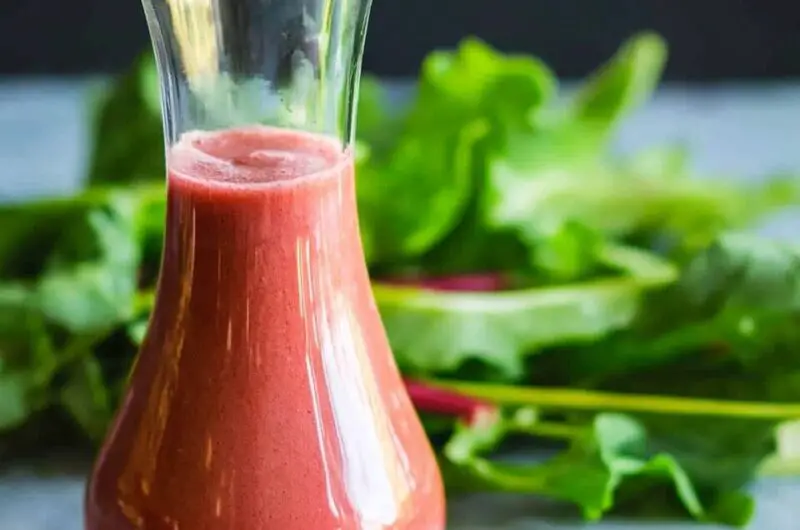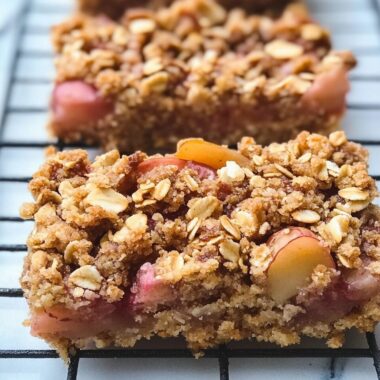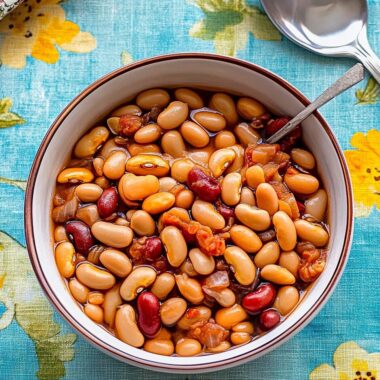The Rhubarb Vinaigrette is a seasonal delight, capturing the bold tartness of rhubarb balanced by the smooth sweetness of honey and the tang of white balsamic vinegar. This creamy, emulsified dressing brings a gourmet touch to any salad, grain bowl, or roasted veggie plate. This vinaigrette is not only beautiful with its soft pink hue but also versatile and easy to prepare. Perfect for spring and summer, it enhances the flavor of greens, fruits, and grilled dishes with its bright, zesty profile. Elevate your salad game with this delightful homemade dressing that’s as unique as it is delicious.
Full Recipe:
Ingredients:
-
1 cup rhubarb, chopped
-
1/2 cup water
-
1/4 cup white balsamic vinegar
-
2 tablespoons honey
-
1 tablespoon Dijon mustard
-
1/3 cup olive oil
-
Salt, to taste
-
Pepper, to taste
Directions:
-
In a small saucepan, combine rhubarb and water. Bring to a boil, then reduce heat and simmer for about 10 minutes until the rhubarb is soft and broken down.
-
Remove from heat and let cool slightly.
-
Transfer the rhubarb mixture to a blender or food processor. Add vinegar, honey, and Dijon mustard. Blend until smooth.
-
Slowly drizzle in the olive oil while blending until the vinaigrette is fully emulsified and creamy.
-
Season with salt and pepper to taste.
-
Store in an airtight container in the refrigerator for up to one week. Shake well before using.
Prep Time: 10 minutes | Cooking Time: 10 minutes | Total Time: 20 minutes
Kcal: 120 kcal per serving | Servings: 6 servings
Discover the Bold Simplicity of Rhubarb Vinaigrette
When most people think of rhubarb, their minds instantly go to sweet desserts rhubarb pie, crumble, or perhaps a tart with strawberries. But rhubarb isn’t just for sweets. Its naturally tart flavor pairs beautifully with savory applications, especially in salad dressings. Enter Rhubarb Vinaigrette a unique, sweet-tart, and vibrant dressing that brings a touch of gourmet flair to everyday meals.
This rhubarb vinaigrette is an unexpected twist that not only utilizes an often-underappreciated spring vegetable but also elevates your salad game with a punch of flavor that’s complex, refreshing, and entirely homemade.
The Unique Role of Rhubarb in Savory Recipes
Though technically a vegetable, rhubarb is most commonly treated like a fruit. Its high acidity and bright red stalks make it perfect for jams and jellies, yet its potential in savory dishes often goes overlooked. In vinaigrettes, rhubarb stands out for its ability to provide both acidity and a natural depth of flavor—think of it as a tangy stand-in for lemon or vinegar, but with more personality.
Rhubarb works beautifully as a base for salad dressings because it blends well, offers a vibrant pink hue, and has a tartness that cuts through richer ingredients. When paired with honey and Dijon mustard, it brings both balance and contrast: sweet vs. sharp, earthy vs. zesty. It’s a combination that’s memorable and extremely versatile.
Why Make Vinaigrette at Home?
In the age of convenience, store-bought dressings are plentiful but they’re not always the healthiest or most flavorful option. Many commercial vinaigrettes include unnecessary preservatives, excessive sugar, or unhealthy fats. Making your own dressing not only ensures that you’re using whole, natural ingredients, but it also gives you total control over flavor and nutrition.
This rhubarb vinaigrette, in particular, is a low-calorie, high-impact dressing. You can whip it up in less than 20 minutes, and it stores well for days. Homemade dressings like this one also allow you to highlight seasonal ingredients and customize to your liking add a splash of lemon for brightness, swap out honey for maple syrup, or include herbs like thyme or tarragon for a unique twist.
Flavor Profile: Sweet, Tart, and Savory in Harmony
What makes this vinaigrette so special is its balance. The rhubarb provides a signature tartness, but it’s softened by the mellow sweetness of honey. Dijon mustard adds complexity, lending a sharpness and a hint of spice that’s subtle but noticeable. White balsamic vinegar ties everything together with a tangy, fruity note, and the olive oil rounds it out with richness and body.
The result is a beautifully emulsified dressing that’s smooth and velvety. Its pink hue adds visual appeal, and the flavor profile is incredibly flexible it’s both bold and delicate, making it suitable for everything from mixed greens to grilled proteins.
Best Pairings and Serving Suggestions
One of the best features of rhubarb vinaigrette is its versatility. It pairs effortlessly with a wide variety of dishes. Here are some great ideas to help you serve it:
1. Greens and Salad Bowls
Use it to dress up a simple salad of mixed greens, goat cheese, and toasted nuts. The tartness of the rhubarb complements the creaminess of soft cheeses and the crunch of seeds or nuts like walnuts and sunflower seeds.
2. Grilled Vegetables
Drizzle it over grilled asparagus, zucchini, or even roasted carrots. The vinaigrette enhances natural vegetable sweetness while cutting through any charred or smoky notes.
3. Grain Bowls
Pour it over quinoa or farro-based grain bowls loaded with veggies and legumes. It works especially well with earthy components like roasted beets, lentils, or chickpeas.
4. Grilled or Roasted Meats
Use it as a finishing drizzle over grilled chicken or pork. The sweetness and acidity in the vinaigrette contrast beautifully with the savory umami of grilled meats, especially when served warm.
5. Fruit-Forward Dishes
Believe it or not, rhubarb vinaigrette also plays nicely with fruit. Try it over a salad that includes strawberries, apples, or blueberries it enhances the sweet fruit with a lively, tart edge.
Nutritional Benefits of Rhubarb and Olive Oil
Not only is this vinaigrette delicious, but it also carries several nutritional benefits. Rhubarb is low in calories and high in antioxidants, particularly anthocyanins the compounds responsible for its red color. It’s also a good source of fiber, calcium, and vitamin K.
Olive oil, a staple in Mediterranean diets, contributes healthy monounsaturated fats and is known for its heart-protective benefits. When you use high-quality olive oil in your vinaigrette, you’re not just adding flavor; you’re improving the healthfulness of your meal.
Honey brings natural sweetness without the spike in refined sugars, and Dijon mustard, made from ground mustard seeds, adds not just flavor but trace amounts of selenium and magnesium.
How to Store and Preserve Your Rhubarb Vinaigrette
Homemade vinaigrettes generally store well, and rhubarb vinaigrette is no exception. Once prepared, pour it into a glass jar or bottle with a tight-fitting lid and store it in the refrigerator.
It’s best used within 5 to 7 days. Because it’s an emulsified dressing (oil blended with water-based ingredients), it may separate over time just give it a good shake before serving.
To extend its shelf life slightly, consider using a splash of lemon juice or a pinch of citric acid, both of which act as natural preservatives while adding to the tart profile.
Making It Your Own: Variations to Explore
While the base recipe is beautifully balanced, there’s plenty of room for creativity. Here are some variations to try:
-
Add herbs: Fresh basil, thyme, or tarragon can introduce aromatic complexity.
-
Use a different sweetener: Maple syrup, agave nectar, or brown rice syrup can change the tone of sweetness.
-
Switch vinegars: Apple cider vinegar or champagne vinegar can provide new layers of acidity.
-
Include citrus: Add lemon or orange zest for a more vibrant, citrusy edge.
-
Make it spicy: A touch of chili flakes or fresh jalapeño can give the dressing a gentle heat.
Each variation can shift the flavor in a subtle but impactful way, depending on your preferences and what you’re serving.
Conclusion:
If you’re looking to break away from store-bought dressings or want to highlight seasonal produce in a creative way, rhubarb vinaigrette is a must-try. It’s flavorful, nutrient-rich, and visually stunning a simple addition that can completely transform your dish.
Not only does it bring a delicious burst of sweet-tart complexity to salads, but it also encourages a new way to use rhubarb in the kitchen. Whether you’re entertaining guests or simply sprucing up a weeknight dinner, this dressing proves that rhubarb has so much more to offer beyond dessert.








